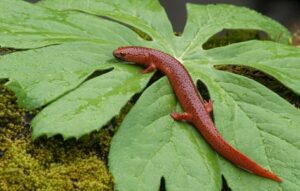Salamanders are famous for one incredible superpower: the ability to regrow lost body parts. If you’ve ever seen one with a short tail or missing toe that eventually grew back, you might wonder just how far that healing ability goes. But is it true for all salamanders?
Most salamanders can regenerate limbs, but not all do it equally well. Some species regrow arms, legs, tails, and even parts of their organs. Others can heal injuries but might not fully regrow complex structures, especially as they get older.
What Does Regeneration Really Mean?
Regeneration isn’t just healing a cut or scar. Salamanders can actually grow back entire body parts, including bones, muscles, nerves, and skin.

If a salamander loses a limb, it doesn’t just patch over the injury. Over time, it rebuilds a complete new limb that looks and works like the original.
This sets salamanders apart from most animals. Mammals, birds, and reptiles can’t do this. Even frogs, which are amphibians too, usually can’t regrow limbs as adults. But salamanders can.
That’s part of what makes them such fascinating model organisms for regeneration research.
Which Salamanders Regrow Best?
Different types of salamanders regenerate at different speeds and to different degrees. Some species are known for their strong regeneration abilities, such as:
- Axolotls – These fully aquatic salamanders are champions at regeneration. They can regrow limbs, gills, parts of their hearts, spinal cords, and even parts of their brains.
- Newts – Many newts are excellent regenerators and often studied in labs for this reason.
- Tiger Salamanders – These common pets and wild species also show strong regrowth ability, especially when they are young.
In general, aquatic and neotenic species (like axolotls) tend to regenerate more reliably and faster than land-dwelling salamanders.

But even salamanders that live mostly on land have some regeneration power. It just might not be as dramatic.
Do They Always Regrow Perfectly?
Not every regenerated limb turns out perfect. Sometimes the new leg or tail grows back smaller or with a slightly different shape. In rare cases, it may be missing toes or have limited movement.
Age plays a role too. Younger salamanders regenerate faster and more completely. Older ones might take longer or regrow less perfectly.
Stress, poor nutrition, or illness can also slow down or reduce the quality of regrowth.
Still, the fact they can do it at all is impressive, especially when most animals can’t.
What About Internal Organs?
Some salamanders can even regenerate parts of their internal organs. Axolotls, for example, have been shown to regrow:
- Sections of the heart
- Portions of the brain
- Segments of the spinal cord
- Parts of the eyes and lungs
This level of regeneration isn’t the same across all salamanders. But it shows how advanced their biology is.
Among animals with regenerative powers, salamanders are in a league of their own.
How Does Regeneration Work?
Regeneration starts with a process called dedifferentiation. Right after an injury, cells near the wound “reset” and turn into stem-like cells.
These cells multiply and rebuild tissues like muscle, bone, and nerves.
The new limb grows from a small bump called a blastema. Over weeks or months, this bump shapes itself into a fully formed limb.
How fast this happens depends on the salamander’s age, health, and environment.
Are There Limits?
Yes, there are limits. While salamanders can do a lot, some things still get in the way.
- Repeated injuries to the same spot might slow or stop full regrowth.
- Severe wounds with infection or heavy blood loss might not heal properly.
- Poor water quality, cold temperatures, or lack of food can interfere.
Also, while many salamanders can regrow legs and tails, very few can regrow entire heads or complex organs fully. Most of what we know comes from lab studies, especially with axolotls.
Do Wild Salamanders Regenerate?
Yes. In the wild, if a predator bites off a salamander’s tail or leg, it may survive and regrow the missing part.
This is one way salamanders escape danger, they can lose a limb or tail and still live on.

But life outside is harder. Infection, hunger, or unsafe conditions might stop the healing. Regeneration takes energy, so a healthy body and habitat matter.
Can You Help a Pet Salamander Regrow?
If your pet salamander loses a limb or tail, you can support healing by:
- Keeping its habitat clean and safe
- Providing good food with plenty of protein and nutrients
- Avoiding stress and handling while it heals
- Watching closely for signs of infection or illness
Not all salamanders regrow limbs equally well. But with good care, many start to form a new limb within weeks and may finish growing it in a few months.
If the injury was very deep or the salamander is old, regrowth might not happen, and that’s okay.
Many salamanders live happy, long lives with missing limbs or toes.
Conclusion
Most salamanders can regenerate lost limbs, and some can regrow parts of organs. This amazing ability makes them unique among vertebrates and fascinates scientists.
But not all salamanders regenerate equally well. Age, species, health, and environment all influence how well it works.
Whether wild or captive, it’s best not to rely on regeneration as a safety net.
Avoid injuries when you can, but know your salamander has a remarkable power to bounce back when cared for properly.
Hi, my name is Ezra Mushala, i have been interested animals all my life. I am the main author and editor here at snakeinformer.com.

